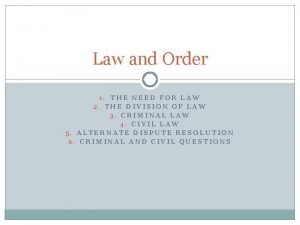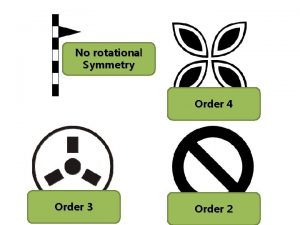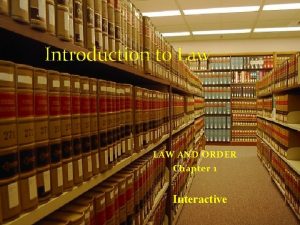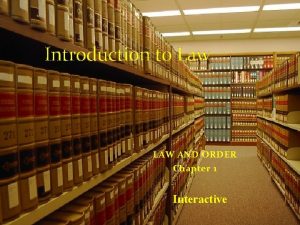Law and Order 1 THE NEED FOR LAW











- Slides: 11

Law and Order 1. THE NEED FOR LAW 2. THE DIVISION OF LAW 3. CRIMINAL LAW 4. CIVIL LAW 5. ALTERNATE DISPUTE RESOLUTION 6. CRIMINAL AND CIVIL QUESTIONS

The Need for Law �We often complain that there are far too many laws. For example, there are laws that regulate how much Canadian content we hear on the radio and laws that tell us when we may water our lawns. But what would happen to our society if we had no laws? Would our society still be able to function?

The Division of Law �Without laws, we would find that the law of the jungle dominated - only the strong would survive. As civilizations grew, there developed a need to ensure that individual and community needs were met and that there was a peaceful way to resolve conflicts. Our legal system provides us with this. In Canada, to meet these needs there have developed over time two broad areas of law - public and private law. Public law is an area which deals with activities between a state and its citizens. The best known example of this type of law is criminal.

Criminal Law � This is one area of law that many of us believe we are very familiar with. We read about it in the newspaper or watch depictions of criminal law in movies or television shows. It is important to realize that much of what we read about or view is based on American law, which does have significant differences from Canadian. For example, in the United States each of the 50 states has its own criminal justice system, while in Canada we have just one for the entire country. For something to be considered a crime, there are three criteria which must be present: � Actus Reus: The guilty act � Mens Rea: The Guilty Mind The act must be prohibited by the Criminal Code of Canada. The accused must have intended to commit the act. The accused must have been able to understand that what they have done is wrong. (For example, anyone under the age of 12 is not considered old enough to understand that they have acted wrongly. )

Criminal Law � In Canada, all criminal laws are divided into two broad areas. The chart below will help you in understanding what they are. Type of Offence Examples of crimes Trial Procedures Punishments Summary Offences Minor or less serious theft under $5000 Receive a summons to appear in court before a judge Maximum penalty is a $2000 fine and/or 6 months in prison Indictable Offences More serious crimes Murder Aggravated assault Armed robbery For most crimes, accused has Maximum sentence is life a choice of a trial with a imprisonment Superior Court judge or by judge and jury For the most serious offences (murder), accused has no choice - must be trial by judge and jury

Civil Law �Private law deals with disagreements between individuals or groups. It is sometimes called civil law. Civil law deals with disagreements that occur between two individuals or groups. There are some significant differences between civil and criminal cases. Some of the important differences are the fact that damages in the form of money may be given to the plaintiff (person making the complaint) and the fact that the defendant cannot be sent to jail.

Civil Law There are many different types of civil law. Three of the most important are: Family Law - which deals with issues such as marriage, divorce, and child custody Contract Law - which looks at whether a contract is legal and enforceable. A contract might involve the purchase of a car or the hiring of someone to fix your television Tort Law - deals with wrongs caused by one person on another. For example, if you slipped and fell on someone's icy stairs, you make this person to court to compensate you for the injuries you suffered as a result of their negligence.

Alternate Dispute Resolution �Legal courts have also begun to use Alternate Dispute Resolution in civil matters. There are three kinds of approaches. Negotiation - this involves the two parties sitting down together to resolve their problems Mediation - this involves the use of a third party who is neutral. This person helps the two parties come to a decision Arbitration - this is used when the two parties are unable to come to a decision. A third person listens to the arguments from both sides and makes a decision which is final.

Criminal Law Questions 1. For each of the following decide if the offence is summary or indictable. If you are not sure, you can check the Criminal Code of Canada at: http: //laws-lois. justice. gc. ca/eng/acts/C-46/ a. defacing a coin b. committing perjury - lying while under oath c. unauthorized use of a computer d. criminal negligence causing death e. injuring or endangering animals f. corrupting children g. impersonating a peace officer h. concealing a terrorist i. towing a person on water-skis at night j. making a harassing phone call

Criminal Law Questions 2. Go to the Criminal Code of Canada and select 3 offences. For each one, tell what the offence is, whether it is summary or indictable, and what the maximum punishment is. a. b. c. 3. Decide for each of the following whether or not an offence has taken place. Give a brief explanation for your decision. a. Jill, a ten year old, was playing with her father's rifle and killed her friend Tom. b. Mark, who was continuously insulted by Adam, could tolerate it no longer and shot him. c. Jason, who escaped from a mental hospital, shot and killed his wife. d. Mrs. Austin, an 85 -year-old, could not bear to see her ill and aged husband suffering any longer, so she gave him an overdose of sleeping pills. e. Danny, while aiming his slingshot at Noah's leg, hit him on the temple and killed him.

Civil Law Questions 1. Thinking of your own life, have you every used any of these alternate dispute resolutions? Select one incident where you had a conflict and describe how you were able to resolve the difficulty. Which alternate dispute resolution did you use? 2. Examine each of the situations below and decide whether or not alternate dispute resolution could be used in this situation. Explain why you have made this choice. a. A person is charged with kidnapping b. A woman wants her fiancé to sign a pre-nuptial agreement c. A couple who are divorcing cannot decide which one should have custody of the family dog. d. A student has to move out of his apartment but he has signed a one-year lease. e. A teen is caught shoplifting a DVD. f. A women believes that she has been discriminated against by her employer. g. A person's dog has bitten a neighbour's child, who required 80 stitches
 Law is order and good law is good order
Law is order and good law is good order Via optica
Via optica Newton's first law and second law and third law
Newton's first law and second law and third law Newton's first law and second law and third law
Newton's first law and second law and third law Kontinuitetshantering
Kontinuitetshantering Typiska novell drag
Typiska novell drag Nationell inriktning för artificiell intelligens
Nationell inriktning för artificiell intelligens Ekologiskt fotavtryck
Ekologiskt fotavtryck Varför kallas perioden 1918-1939 för mellankrigstiden
Varför kallas perioden 1918-1939 för mellankrigstiden En lathund för arbete med kontinuitetshantering
En lathund för arbete med kontinuitetshantering Kassaregister ideell förening
Kassaregister ideell förening Tidbok yrkesförare
Tidbok yrkesförare




















